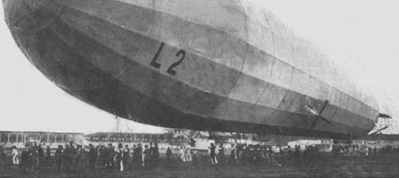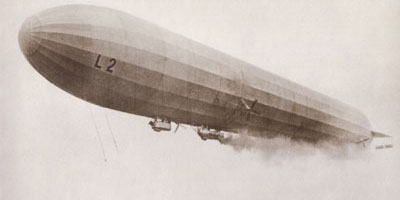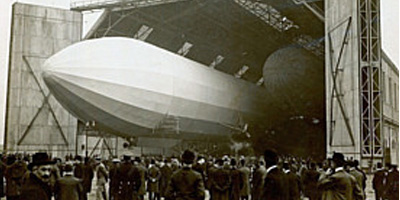
Marine-Luftschiff L2 – Zeppelin LZ18
Die Presse international zum Unglück des Marine-Luftschiff L2 (Zeppelin LZ 18)
Österreich
Wien, 17.10.1913
Die Wiener Blätter drücken in herzlichen Worten den aufrichtigen Schmerz und das innigste Mitgefühl ganz Österreichs zu dem Unglück aus, welches das Deutsche Reich durch die Katastrophe des Marine-Luftschiff L2 und durch den Verlust so vieler tapferer Menschenleben neuerlich betroffen habe.
Die allgemeine Teilnahme wendet sich besonders auch dem Grafen Zeppelin zu, dem durch alle bisherigen Widrigkeiten in seiner Willens- und Arbeitskraft ungebeugten Erfinder und Erbauer der nach ihm benannten Luftschiffe.
Die Blätter sprechen die Überzeugung aus, daß auch diese Katastrophe wie alle mit Gut und Blut jetzt schon so teuer erkauften Erfahrungen, die Eroberung der Luft und den Siegesweg der Luftschiffahrt nicht aufhalten könne.
Niederlande
Amsterdam, 18.10.1913
Das Amsterdamer “Handelsblad” bespricht die Katastrophe des Marine-Luftschiff L2, und drückt seine aufrichtige Teilnahme für das deutsche Volk aus, das so tüchtige Mitbürger verloren habe, ferner für die Marinebehörden und besonders für den alten Grafen Zeppelin, dessen Trübsale nicht enden zu wollen scheinen.
Frankreich
Paris, 18. 10.1913
In den Bemerkungen der Pariser Presse über das Zeppelin-Unglück kommt ziemlich allgemein die Ansicht zum Ausdruck, daß die neue Katastrophe dem Zeppelin-Lenkballon eine schwere, wenn nicht eine entscheidende Niederlage zugefügt habe. Diese Ansicht wird von hervorragenden Fachleuten auf dem Gebiete der Aeronautik geteilt. Man weist darauf hin, daß die Elemente an diesem Unfall keinen Anteil hatten, daß vielmehr zur Zeit der Katastrophe das prächtigste Wetter herrschte.
Der “Figaro” meint:
“Es gibt in Frankreich niemanden, der nicht voll Respekt diese allzu zahlreichen Opfer der Luft begrüßen wird.”
Die “Debats” u.a.:
Ein natürliches Gefühl des Mitleids und der sympathischen Gemeinbürgschaft regt sich unter diesen ernsten Umständen für die Opfer des grauenhaften Unfalles und für unsere Nachbarn, die kein Fehlschlag entmutigt. Dem Mißgeschick, das ihre Zeppeline hartnäckig verfolgt, gelingt es weder, ihr kräftiges Vertrauen zu erschüttern, noch ihre Tätigkeit zu verlangsamen. Ein Lenkballon verschwindet – ein anderer ersetzt ihn. Damit gibt Deutschland ein Beispiel der Standhaftigkeit und Energie, das zu bewundern man sich nicht verhindern kann.
England
London, 18.10.1913
Der “Daily Chronicle” schreibt:
Deutschland hat für die Eroberung der Luft einen hohen Preis bezahlt, höher als irgendeine andere Nation. Frankreich hat vielleicht hundert seiner Söhne verloren, Deutschland trauert um eine viel größere Zahl. Der L2 ist der zehnte Lenkballon des Zeppelinschen Systems, der einer Katastrophe zum Opfer fällt. Die lange Liste dieser Unfälle muß schließlich das Zutrauen an die Nützlichkeit der Lenkluftschiffe zerstören. Es ist heute klar, daß die Zukunft dem Flugzeug und nicht dem Lenkluftschiff gehört.
Die “Daily Mail” erklärt:
Der Umstand, daß zu den Gefahren einer Zerstörung durch Unwetter noch die Gefahr der Explosion kommt, muß notgedrungen die Zweifel über den Wert der Lenkluftschiffe erhöhen.
Die “Times” schreibt:
Unter diesen tragischen Umständen wäre es verzeihlich, wenn sich auch nur zeitweise ein Gefühl der Depression des deutschen Publikums bemächtigte. Aber wir würden sehr enttäuscht sein, wenn der Verlust zweier so großartiger Luftschiffe den Fortschritt in der aeronautischen Entwicklung Deutschlands auch nur einen Tag aufhielte. Wenige Stunden nach dem Unglück des L2 flog das Passagierschiff “Hansa” über Berlin hinweg. Die Trauernden werden in ihm ein Ermutigungszeichen für die Zukunft erblickt haben.
Major Powell, ein Mann, dessen Wort im Kreise der Luftschiffer gehört zu werden verdient, richtete einen Brief an die Times, in dem er die Wissenschaft beschwört, alles aufzubieten, um ein unexplodierbares Gas zu erfinden, das geeignet sei, für Luftschiffe Verwendung zu finden.
Im “Daily Telegraph” steht:
In diesem Augenblick wendet sich die Sympathie des britischen Volkes, dessen eigene Empfindungen durch die letzten Ereignisse in Aufregung versetzt worden waren, in Bewunderung und Trauer dem gesamten Volke jenseits der Nordsee zu. Das deutsche Volk erhebt sich gegen diesen Schlag mit einer Mündigkeit, die unsere Bewunderung erregt. Der sofortige Entschluß, das andere Luftschiff aufsteigen zu lassen, schlug in dieser Stunde der Trauer eine Note an, welche die Engländer zu würdigen wissen.
Die Deutschen teilen mit uns die Eigentümlichkeit, sich nach einer augenblicklichen Niederlage stolz emporzurichten und den Entschluß, nicht zurückzuweichen, nur weil ein Unglücksfall sie betroffen. Wir hegen keinen Zweifel, daß das Ziel der Entwicklung des vollkommenen Luftschiffes trotz aller Schrecken nicht nur in Deutschland, sondern auch in England weiter verfolgt werden wird.







